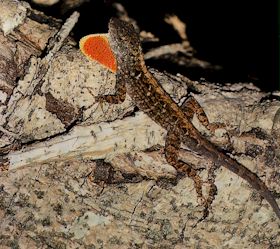
Introduction
Members of the genus Anolis, commonly called
Anoles, are one of the most distributionally
widespread and diverse group of reptiles in the
Western Hemisphere. Ranging throughout North
America, Central America, South America, and the
Caribbean, this group is comprised of more than 350
species. (Poe, personal communication) Of these
350+ species, 19 are known to be invasive. (Lever, 2003)
An invasive species is defined as a species that has
established stable reproducing populations outside
of their native range. These species can significantly
impact their new environments and many have been
shown to have major ecological and economic impacts.
(Strauss, 2006) For this reason it has been increasingly
important to develop measures to mediate these negative Anolis sagrei
impacts and to predict future invaders. (Strauss, 2006)
Many recent studies have used ecological niche modeling programs to predict environmental suitability for invasives as well as for predicting possible future invasives. (Hijmans et. al. 2001, Ganeshaiah, K.N. et. al. 2003) These programs, for example, Diva-GIS and GARP(Genetic Algorithm for Rule Set Prediction), use climate and ecological datasets coupled with new algorithms to model areas of climatically suitable habitat to predict the spread of invasive species in novel habitats. (Hijmans et. al. 2001, Ganeshaiah, K.N. et. al. 2003) Within the Diva-GIS application, the BIOCLIM (Bio-climatic analysis and prediction system) algorithm uses a worldwide dataset of 19 climate and ecological variables for predictive modeling.
The species of interest in this analysis is the Brown or Bahaman Anole (Anolis sagrei). Native to Cuba, Jamaica, the Bahamas, and Belize, Anolis sagrei is a broadly ranging, medium sized Anole. (Schwartz and Henderson, 1991) It lives in a wide variety of habitats, preferring sunny areas of open vegetation where it is often found on the ground or in low vegetation. It is often very abundant in disturbed habitat and in urban areas. (Schwartz and Henderson, 1991) The medium body size and cosmopolitan habitat preferences of this species are likely suitable for invasion. Outside of its’ native ranges, Anolis sagrei has become naturalized in the United States in the states of Florida, Georgia, Texas, Alabama, Louisiana and Hawaii. It also has invasive populations in South America and Japan. (Lever, 2003) This high degree of invisibility, coupled with the availability of native distributional data makes Anolis sagrei a great study species.
